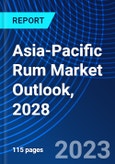This report comes with 10% free customization, enabling you to add data that meets your specific business needs.
1h Free Analyst TimeSpeak directly to the analyst to clarify any post sales queries you may have.
According to the research report, Asia-Pacific Rum Market Outlook, 2028 the market is expected to grow with 3.45% CAGR by 2023-28. White or silver rum is popular in the Asia Pacific due to its versatility and use as a base for cocktails. Its neutral flavor profile allows it to blend well with various ingredients, making it an ideal choice for tropical and fruity mixed drinks. Additionally, the relatively affordable price point of white rum makes it accessible to a wide range of consumers. Premium and artisanal rums are gaining traction in the Asia Pacific as consumers are willing to explore unique and high-quality spirits. It's important to recognize that preferences can vary significantly across different countries within the Asia Pacific region. For example, in countries like the Philippines and Thailand, locally produced rums have a strong following and are highly regarded. Tanduay, Thai Beverage Public Company Limited (ThaiBev), Havana Club, Bundaberg Rum are the companies in Asia Pacific in Rum Market. Tanduay (Philippines), Mekhong (Thailand), SangSom (Thailand), Bundaberg Rum (Australia), Old Monk (India) are some popular brands. Each country within the Asia Pacific region has its own rich cultural heritage, traditions, and history related to alcohol production and consumption. Exploring the rum market in countries like the Philippines, Thailand, India, or Japan provides an opportunity to delve into the unique drinking customs, rituals, and stories associated with rum.
White or silver rum is a popular choice in the Asia Pacific region due to its versatility and suitability for cocktails. It is often used as a base spirit for tropical and fruity rum-based drinks, which align with the region's preference for refreshing and lighter flavors. Conventional rum production methods are typically more cost-effective and widely accessible to producers in the region. Organic rum production often requires adherence to specific organic farming practices and certification processes, which can be more expensive and challenging to implement for many distilleries. In the Asia Pacific region, the drinking culture revolves around socializing, celebrating, and enjoying a wide variety of flavors. This cultural context has influenced the preference for standard rum .Standard rum, with its moderate alcohol content, allows for the creation of well-balanced cocktails that showcase the diverse flavors and ingredients of the region. The rum market in the Asia Pacific region faces stiff competition from other spirits categories such as whiskey, vodka, and local spirits. These spirits have established consumer bases and cultural associations, making it challenging for rum to gain significant market share. The presence of well-established domestic brands and the popularity of local spirits can further limit the growth and penetration of rum in certain markets.
Old Monk, Bacardi, McDowell's No. 1, Malibu are the some of the brands in India for rum. India is a major player in the global rum industry and its importance in the rum market may be ascribed to a number of factors. First off, India's sizable consumer base and expanding middle class provide rum makers a sizable market. In a country with a population of more than 1.3 billion, there is a high demand for alcoholic beverages, especially rum, creating a thriving business. Culturally, rum holds a prominent place in India. It has been a part of the country's drinking traditions for centuries, particularly in coastal regions where local varieties of rum are produced. This cultural familiarity and acceptance of rum contribute to its widespread consumption and market significance. The entry of international rum brands into the Indian market has further strengthened its significance. Global players like Bacardi, Captain Morgan, and Malibu have recognized the potential and established a strong presence in India. Their marketing strategies, brand recognition, and diverse product offerings have expanded the choices available to Indian consumers and stimulated the growth of the rum market.
In the Asia Pacific region, rum is primarily distributed through retail outlets like supermarkets, liquor stores, and convenience stores, where customers may discover a variety of rum brands. Duty-free stores located in popular tourist areas and airports are important distribution routes. Consumers can now effortlessly buy rum items through e-commerce platforms thanks to the growth of online retail. Hotels, taverns, and restaurants are essential to the distribution of rum because they give customers access to rum-based cocktails and beverages. The supply chain also includes distributors and wholesalers, whose efficient distribution from producers to various retail stores and hospitality places is a crucial component.
Considered in this report
- Geography: Asia-Pacific
- Historic year: 2017
- Base year: 2022
- Estimated year: 2023
- Forecast year: 2028
Aspects covered in this report
- Asia-Pacific Rum market with its value and forecast along with its segments
- Country-wise Rum Market analysis
- Various drivers and challenges
- On-going trends and developments
- Top profiled companies
- Strategic recommendation
Countries covered in the report:
- China
- Japan
- India
- Australia
- South Korea
- Philippines
By Types Rum
- White Rum
- Light or Gold Rum
- Dark Rum
- Spiced and Flavored
By Nature
- Conventional
- Organic
By Category
- Standard
- Over proof
By Segment
- Mass
- Premium /Craft Rum
By Distribution Channel
- On -Trade
- Off-Trade








